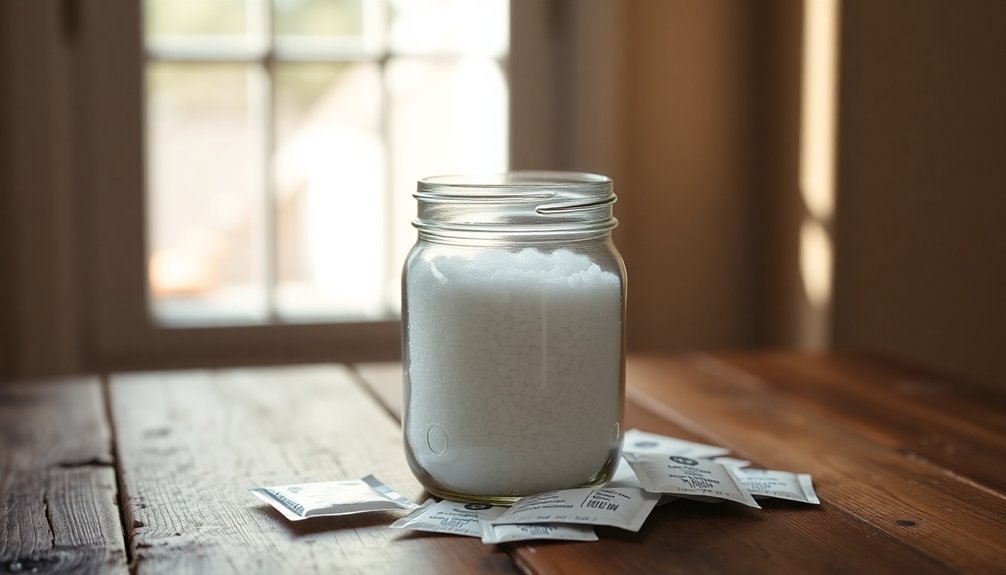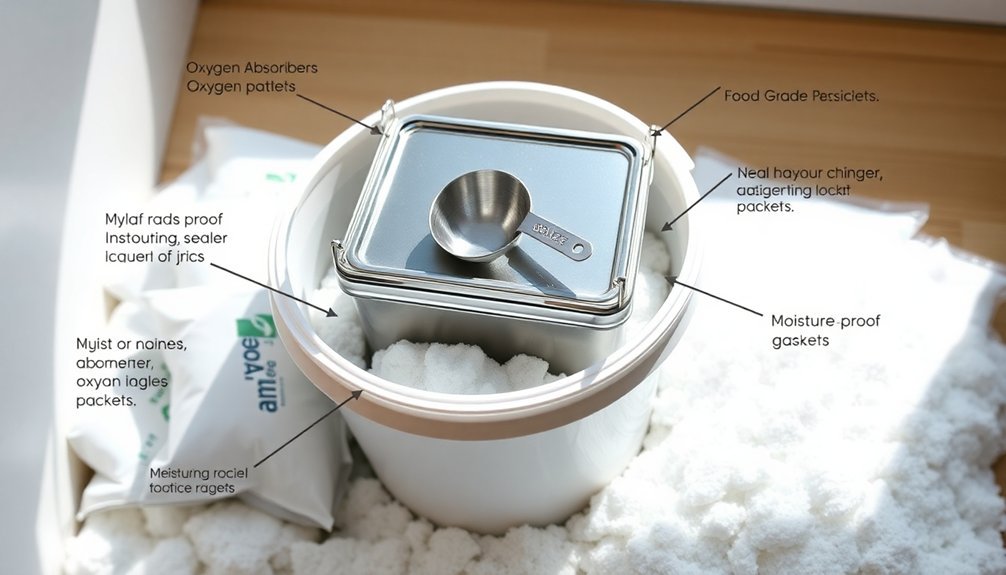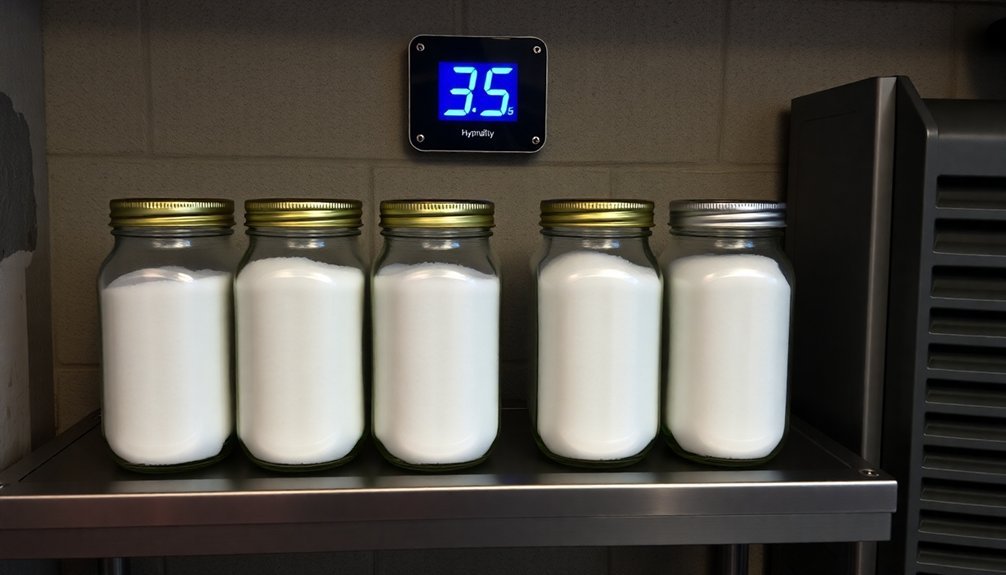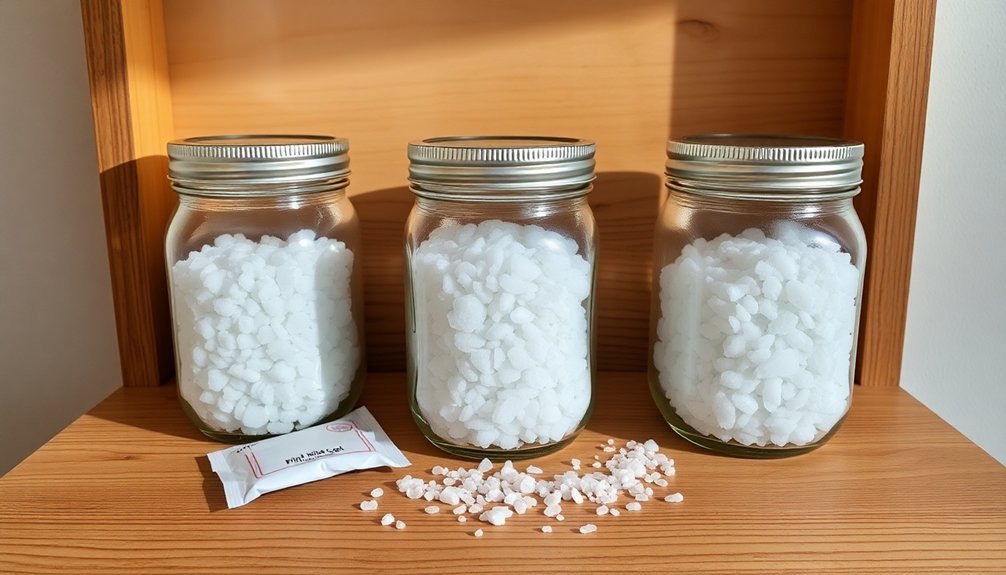Store your salt effectively using these seven proven methods: Glass mason jars with airtight seals prevent moisture and clumping, while vacuum-sealed food-grade bags offer portioned convenience. Food-grade bucket systems with gamma lids provide bulk storage options, and moisture-free pantry solutions keep salt dry with rice as a natural desiccant. Climate-controlled basement areas maintain consistent conditions, while proper desiccant packaging methods use silica gel packets for humidity control. Rice-based humidity control in salt shakers prevents daily-use clumping. Each method has unique advantages, and understanding their specific benefits will help you choose the perfect storage solution for your needs.
Glass Mason Jar Storage

When it comes to storing salt long-term, glass Mason jars stand out as one of the most reliable solutions. You'll find these containers particularly effective because they feature airtight seals and are made from non-reactive materials that won't corrode like metal containers do.
Wide-mouth versions offer the easiest access for both storing and retrieving your salt. These containers were historically favored because salt was currency in many ancient civilizations.
You should place your Mason jars in a cool, dry, and dark location to maintain peak freshness. This storage method works exceptionally well because it prevents moisture from entering the container, which helps avoid salt clumping.
You'll want to keep your jars away from humid areas and strong odors that could contaminate the salt's flavor.
If you're looking to maximize your storage efficiency, you can use different jar sizes for various needs. Keep smaller jars on your kitchen counter for daily use, while larger ones work well for long-term storage in your pantry.
When you store salt properly in Mason jars, it'll last indefinitely – though you should note that iodized salt will gradually lose its iodine content over time.
For a cost-effective approach, consider buying salt in bulk and redistributing it into multiple Mason jars.
Vacuum-Sealed Food Grade Bags
Vacuum-sealed food grade bags offer a modern solution for preserving salt over extended periods. You'll want to select bags with textured inner surfaces that facilitate proper air removal during the sealing process.
When preparing your bags, divide your salt into manageable portions, but don't overfill them, as this can lead to punctures. You'll achieve the best results by using a vacuum sealer machine to remove air and create an airtight seal. Food vacuum-sealers are essential tools for this preservation method and brands like FoodSaver™ work well for sealing dry goods.
While oxygen absorbers aren't necessary and can actually cause clumping, you should wrap the sealed bags in plastic wrap for added protection. After sealing, check thoroughly for any air leaks to guarantee proper preservation.
Store your vacuum-sealed salt bags in a cool, dry, and dark location. You can enhance protection by placing them in Mylar bags or plastic storage bins, but avoid metal containers that might corrode.
If you're concerned about humidity, consider adding silica gel packets to your storage area. Your vacuum-sealed salt will remain usable indefinitely, though texture may change over time.
The sealed bags will protect against moisture, pests, and environmental contaminants while making it easy to manage your salt storage in smaller portions.
Food-Grade Bucket Systems

Food-grade bucket systems' effectiveness lies in their specialized construction from FDA-approved HDPE plastic. You'll find these buckets particularly suitable for salt storage, as they're BPA-free and won't corrode like metal containers. The uniformly thick sidewalls and reinforced Saturn rings provide excellent stacking strength, while the tapered design allows for easy separation when needed. These buckets come in white colors only to meet USDA food-grade standards.
| Feature | Benefit | Consideration |
|---|---|---|
| HDPE Material | Food-safe, durable | Avoid used chemical buckets |
| Gamma Lids | Airtight seal | Higher cost than snap-on |
| Mylar Bags | Extra moisture barrier | Must seal within 20 mins |
| Multiple Sizes | Storage flexibility | Consider weight limits |
For the best results, combine your bucket system with Mylar bags, but skip the oxygen absorbers for salt storage. You'll want to choose either 3.5 or 5-gallon sizes based on your needs, though smaller buckets often prove more practical for regular access. Store your sealed buckets in a cool, dry, and dark location to maintain excellent preservation. If you're storing iodized salt, you'll need to implement a rotation system due to iodine evaporation, though non-iodized salt can last indefinitely when properly stored.
Moisture-Free Kitchen Pantry Solutions
You'll find Mason jars are perfect for creating an organized pantry system that keeps salt and other moisture-sensitive ingredients completely dry.
Adding a few tablespoons of uncooked rice at the bottom of each jar acts as a natural desiccant, drawing moisture away from your stored ingredients.
These airtight glass containers, combined with the rice-based humidity control method, create an effective moisture barrier while allowing you to easily monitor your ingredients' condition through the transparent sides.
Mason Jar Pantry Systems
Mason jars represent one of the most effective storage solutions for maintaining a moisture-free pantry environment. Their two-part lid system creates an airtight seal that's essential for preserving dry goods, especially when combined with vacuum sealing attachments. You'll find these jars particularly useful for storing salt and other pantry staples while keeping moisture at bay.
- Vacuum sealing removes air and prevents insect infestation while extending food shelf life
- Compatible with regular and wide-mouth attachments for versatile storage options
- Transparent design allows you to monitor content levels without opening containers
- Uniform sizing maximizes shelf space and creates an organized storage system
To optimize your Mason jar pantry system, you'll want to maintain proper humidity control. Consider installing a hygrometer to monitor moisture levels and use silica gel packets or kitchen dehumidifiers when needed.
The jars' standardized sizes make them perfect for streamlining your pantry organization, replacing bulky packaging with neat, stackable containers. You'll appreciate how easy it becomes to track your inventory when everything's visible through clear glass, and you can quickly identify when it's time to restock essential items.
#
Rice-Based Humidity Control
Through centuries of traditional food storage practices, rice has proven to be a reliable natural desiccant for maintaining moisture-free pantry environments. When you're storing salt, spices, or grains, adding dry rice to your containers creates an effective moisture barrier that prevents clumping and preserves quality.
| Rice Storage Benefits | Implementation Tips |
|---|---|
| Prevents salt clumping | Add 2-3 tablespoons of rice per container |
| Natural moisture absorption | Replace rice every 3-4 months |
| Cost-effective solution | Use uncooked white rice only |
| No chemical additives | Keep containers sealed tightly |
| Easy to implement | Store in cool, dry location |
You'll find that combining rice with other moisture-control methods amplifies its effectiveness. Place your storage containers on elevated wire shelves to improve air circulation, and consider adding silica gel packets alongside the rice for maximum humidity control. Don't forget to check your containers regularly and replace the rice when it starts feeling slightly damp. For ideal results, keep your pantry well-ventilated and maintain consistent temperature levels. Remember that proper air circulation is essential, so avoid plastic shelving that can trap moisture.
Climate-Controlled Basement Storage

When preparing a climate-controlled basement for salt storage, maintaining consistent temperature and humidity levels is crucial for preserving your salt's quality.
You'll need to choose a well-ventilated area away from water sources, pipes, or areas prone to moisture accumulation. Make certain your basement has proper drainage and a sloped foundation to prevent water from seeping toward your salt storage area.
- Install dehumidifiers to actively control moisture levels
- Use airtight food-grade plastic containers with secure lids
- Place storage containers on elevated platforms or pallets
- Monitor temperature and humidity with digital sensors
Select a spot that's easily accessible but secure from children and pets. You'll want to position your storage containers away from direct sunlight and any basement windows.
If you're using multiple containers, stack them carefully to prevent tipping, and always label each one clearly. Don't forget to use protective gear when handling large quantities of salt.
While metal shelving might seem sturdy, opt for plastic or wooden storage solutions instead, as salt can corrode metal over time.
Keep your storage area clean and check regularly for signs of moisture or container damage to guarantee your salt remains dry and free-flowing.
Desiccant Packaging Methods
You'll want to start with food-grade silica gel packets as your primary moisture control, which meet strict safety standards for use with consumables like salt.
For a budget-friendly alternative, you can create your own desiccant packets using uncooked rice sealed in breathable cloth pouches, though these won't be as effective as commercial options.
Combining these moisture-control methods with oxygen absorbers provides the most thorough protection for your stored salt, especially in high-humidity environments.
Using Food-Grade Silica Gel
Food-grade silica gel stands as an essential component in effective salt storage, offering superior moisture control that prevents clumping and extends shelf life. When you're storing salt long-term, you'll want to integrate these non-toxic desiccant packets into your storage containers to maintain ideal dryness levels.
- Compatible with both airtight containers and Mylar bags, protecting against moisture intrusion
- Changes color when saturated, letting you know exactly when replacement is needed
- Works effectively alongside oxygen absorbers for thorough storage protection
- Safe for food contact due to premium-grade materials and strict quality standards
You can maximize the effectiveness of silica gel by placing packets at the bottom of your salt containers, where they'll efficiently absorb any moisture that settles.
For best results, combine silica gel with vacuum-sealed packaging methods to create an ideal storage environment. The porous OPP packaging of food-grade silica packets ensures consistent moisture absorption while maintaining strong seal integrity.
When you're storing large quantities of salt, you'll find that silica gel's ability to perform in various humidity conditions makes it particularly valuable for maintaining your salt's free-flowing quality over extended periods.
DIY Rice Desiccant Packets
Creating your own rice desiccant packets offers up a cost-effective alternative to commercial moisture absorbers for salt storage.
You'll need basic white rice, No. 2 cone coffee filters, and a stapler to get started. If you're planning to make larger packets, No. 4 filters work well for bigger portions.
To assemble your packets, cup a coffee filter in your hands and add about 2 tablespoons of rice. Carefully fold the filter over to enclose the rice completely, then secure it with 3-4 staples across the top. You can make multiple packets at once using a pound of rice.
These DIY desiccant packets work effectively when placed inside your salt storage containers, helping prevent clumping and moisture absorption. You can also use them in other dry goods like flour, sugar, pasta, and beans.
They're particularly useful in high-humidity environments or storage areas where moisture control is essential.
Keep in mind that these rice packets are single-use items and can't be recharged like silica gel packets. Make sure you've sealed them securely to prevent any rice from escaping into your stored goods.
Oxygen Absorber Combinations
When combining oxygen absorbers with desiccants, proper placement and timing are essential for maximum effectiveness. Place your silica gel packets at the bottom of your container and oxygen absorbers on top to guarantee even distribution.
You'll want to seal your package immediately after adding the oxygen absorber to prevent it from working on outside air instead of protecting your stored items.
For maximum protection of your stored goods, consider these critical factors:
- Place both desiccants and oxygen absorbers evenly throughout larger containers to maintain consistent protection.
- Store your sealed packages in a cool, dark place to maintain the effectiveness of both preservation methods.
- Check oxygen absorbers regularly for color changes or hardening, which indicate they need replacement.
- Don't reuse oxygen absorbers – store unused ones in airtight containers for future use.
Remember that while this combination works well for many items, you shouldn't use oxygen absorbers with salt storage.
Salt has an indefinite shelf life without them and can actually become hard when exposed to oxygen absorbers. Instead, focus on moisture control for salt using desiccants or vacuum sealing methods.
## Rice-Based Humidity Control

Rice's remarkable moisture-absorbing properties make it an ideal companion for keeping salt free-flowing and clump-free. When you add a few grains of uncooked rice to your salt shaker, you'll harness its natural hygroscopic ability to draw moisture away from the salt, preventing those frustrating clumps that can clog your shaker.
To implement this method, start with a completely dry salt shaker and fill it about three-quarters full with salt. Add approximately half a teaspoon of uncooked rice grains, seal the shaker, and gently mix the contents. You'll find that the rice stays contained within the shaker while effectively controlling humidity.
For best results, you'll want to combine this rice method with proper storage techniques. Keep your salt containers in a cool, dry area away from heat sources and water exposure. Choose glass containers or food-grade storage solutions instead of metal ones, as salt can be corrosive.
If you're storing bulk quantities, consider keeping them outside the kitchen where humidity levels are typically lower.
Don't forget to regularly check your stored salt to verify it remains dry and free-flowing. The rice will continue working effectively as long as you maintain proper storage conditions.
Frequently Asked Questions
Can I Mix Different Types of Salt in the Same Storage Container?
You shouldn't mix different salt types in one container, as they have varying moisture sensitivities and can cause clumping. The salts' distinct properties may lead to quality degradation and inconsistent flavor profiles.
How Often Should I Check Stored Salt for Quality Maintenance?
You should inspect your stored salt weekly for moisture and clumping. During humid seasons, check twice weekly. Don't forget to examine container seals, ventilation, and temperature conditions during these quality maintenance checks.
Will Storing Salt Near Other Preserved Foods Affect Either Product?
You'll find that properly stored salt won't affect other preserved foods, but you should keep it in airtight containers away from moisture-rich items to prevent clumping and avoid any potential odor absorption.
Does Electromagnetic Radiation From Appliances Affect Long-Term Salt Storage?
You don't need to worry about electromagnetic radiation from appliances affecting your stored salt. There's no evidence that it impacts salt, but you should focus on keeping salt dry and in airtight containers.
Can I Reuse Desiccant Packets From Other Products for Salt Storage?
Yes, you can reuse desiccant packets from other products as long as they're intact and properly reactivated first. Just heat them in the oven at 175°F for 15 minutes to restore their moisture-absorbing capabilities.
In Summary
Whether you're storing salt for emergency preparedness or culinary use, you've now got multiple reliable methods at your disposal. Choose glass jars for smaller quantities, vacuum-sealed bags for portability, or food-grade buckets for bulk storage. Remember to keep your salt away from moisture using desiccants or rice-based humidity control. With proper storage techniques, you'll maintain your salt's quality for years to come.





Leave a Reply